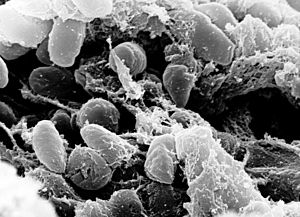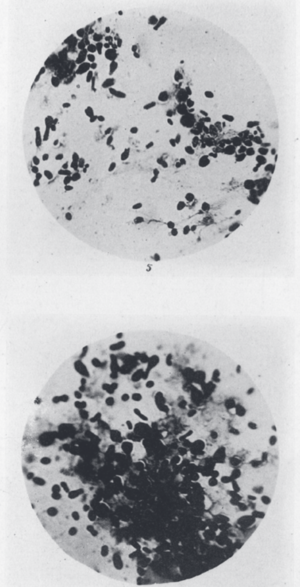Yersinia pestis facts for kids
Quick facts for kids Yersinia pestis |
|
|---|---|
 |
|
| A scanning electron micrograph showing a group of Yersinia pestis bacteria inside a flea. | |
| Scientific classification | |
| Genus: |
Yersinia
|
| Species: |
pestis
|
| Synonyms | |
|
|
Yersinia pestis is a type of bacterium that causes a disease called plague. It is famous for causing the Black Death, which was a very serious pandemic in history. This germ is shaped like a small rod and does not move on its own. It is related to other bacteria that can cause stomach sickness.
This bacterium can live with or without oxygen. It mostly infects small animals like rats. It spreads to humans through the bites of fleas that live on these rats. It can also spread through the air if a person has a lung infection.
A scientist named Alexandre Yersin discovered Y. pestis in 1894. He found it while studying a plague outbreak in Hong Kong. The bacterium was named after him. Today, the plague is rare, but it still exists in some parts of the world. Doctors can treat it with medicine called antibiotics.
Contents
Characteristics of the Bacteria
Yersinia pestis looks like a safety pin when viewed under a microscope with special dyes. It grows best at temperatures between 28 °C and 30 °C (82–86 °F). However, it is very sensitive to sunlight and heat. If it is exposed to ultraviolet (UV) light or gets too hot (above 40 °C or 104 °F), it dies quickly.
This bacterium belongs to a group called Yersinia. There are 11 species in this group, but only three of them make humans sick. The other two usually come from eating food or water that is not clean.
How the Bacteria Spreads
The bacteria usually spread among wild rodents, like rats, squirrels, and prairie dogs. Fleas bite these animals and drink their blood. If the animal is sick, the flea swallows the bacteria.
The Role of Fleas
When a flea drinks blood containing Y. pestis, the bacteria grow inside the flea's stomach. They form a sticky clump called a biofilm. This clump blocks the flea's stomach so it cannot swallow food. The flea becomes very hungry and tries to bite a new host, like a human or another animal. Because its stomach is blocked, the flea spits the bacteria into the bite wound. This is how the infection starts.
Animals Involved
Many types of rodents can carry these bacteria.
- In the United States, animals like prairie dogs, ground squirrels, and chipmunks carry it.
- In Asia, it is found in marmots and gerbils.
- In Africa, rats and gerbils are common carriers.
Sometimes, pets like cats and dogs can get sick if they are bitten by infected fleas or eat a sick rodent. Cats are more likely to get very sick than dogs. Humans can catch the disease from their pets through bites, scratches, or by breathing in droplets if the animal coughs.
How it Affects the Body
When the bacteria enter the body, they travel to the lymph nodes. These are small organs that help fight infection. The bacteria multiply there, causing the lymph nodes to swell and become painful. This swelling is called a "bubo," which is why one form of the disease is called bubonic plague.
The bacteria have special tools to hide from the body's immune system. They produce proteins that stop white blood cells from eating them. They can also inject harmful substances into the body's cells to stop them from sending warning signals. This allows the bacteria to grow quickly before the body can fight back.
History and Discovery
In 1894, two scientists, Alexandre Yersin and Kitasato Shibasaburō, went to Hong Kong to study a plague outbreak. They both found the bacteria, but Yersin is given credit for the discovery because his description was more accurate. He originally named it Pasteurella pestis. In 1967, it was renamed Yersinia pestis to honor him.
Another scientist, Paul-Louis Simond, discovered that fleas were responsible for spreading the disease from rats to humans. He noticed that people got sick after handling dead rats. He proved his theory with experiments showing healthy rats got sick after being bitten by fleas from infected rats.
Ancient History and DNA
Scientists study the DNA of Y. pestis found in ancient skeletons to learn about history.
- The Black Death: In 2010, researchers confirmed that Y. pestis caused the Black Death in the 14th century.
- Bronze Age: In 2015, scientists found the bacteria in teeth from people who lived 5,000 years ago. This showed that the plague has been infecting humans for a very long time.
- Recent Findings: In August 2025, researchers found the bacteria's DNA in the teeth of sheep from the Bronze Age in Russia. This suggests that farm animals might have helped spread the disease to humans long ago.
Modern Prevention and Treatment
Today, the plague is treatable. Doctors use antibiotics to kill the bacteria. If people get medicine quickly, they usually recover.
There are still between 1,000 and 2,000 cases reported to the World Health Organization each year. Most cases happen in Africa, specifically in the Democratic Republic of the Congo and Madagascar, as well as in Peru. In the United States, there are usually a few cases each year in western states like New Mexico and Arizona.
Scientists have worked on vaccines to prevent the plague, but they are not widely used. The best way to prevent the disease is to avoid contact with wild rodents and to protect pets from fleas.
Genetic Information
Scientists have mapped the entire genetic code (genome) of Y. pestis. They found that it has about 4,000 genes. It also has small circles of DNA called plasmids. These plasmids carry the instructions for making the dangerous proteins that help the bacteria survive in fleas and infect humans.
The bacteria is very similar to another germ called Yersinia pseudotuberculosis, which causes mild stomach issues. DNA studies show they are 83% identical. Scientists believe Y. pestis evolved from this milder ancestor thousands of years ago.
See also
 In Spanish: Yersinia pestis para niños
In Spanish: Yersinia pestis para niños



